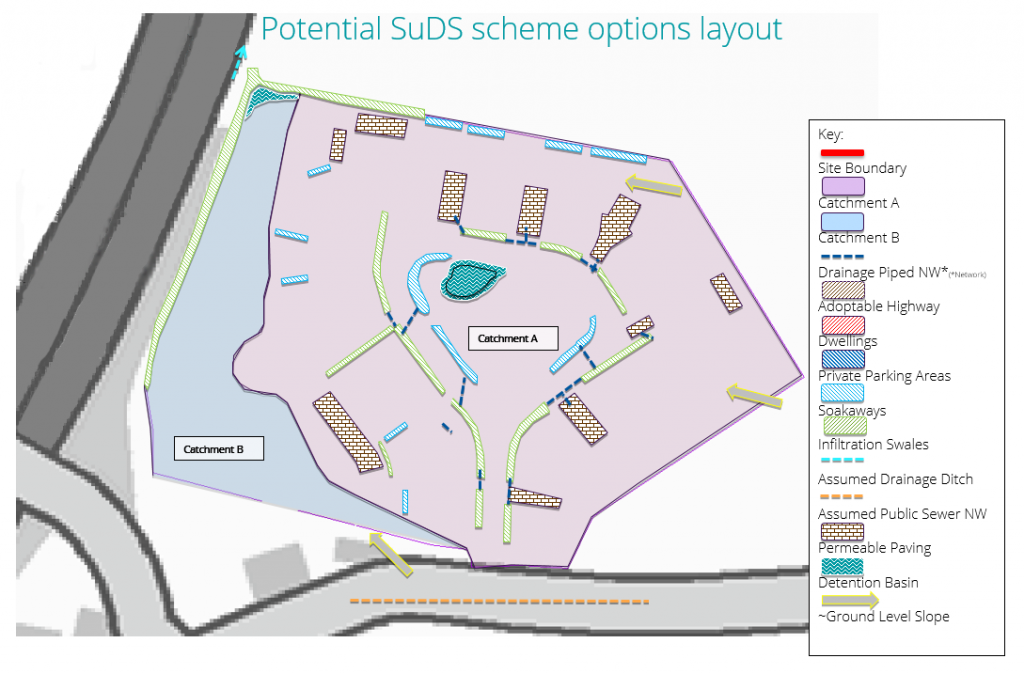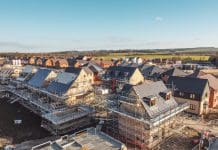Stuart Pearce, Managing Director, GeoSmart Information explains the importance of planning developments with sustainable drainage systems in mind
Improving the country’s resilience to flooding is driving the need for a new approach to managing surface water runoff. Existing drainage systems and sewers have a limited capacity and the increase in surface water from developments mean that we can no longer rely on this infrastructure to cope with surface water on site. Add to this the impact of climate change and the risk and severity of flooding increases.
Planning policy requires that development must accommodate additional runoff on site, and only rely on the existing drainage network as a last resort where it is not practical to manage the additional water within the site. This calls for a new approach and help is at hand for developers in the shape of Sustainable Drainage Systems (SuDS) which are designed to replicate the natural drainage from the site (pre-development) to mitigate the flood risk. They provide areas for water storage and drainage as close as possible to where the rain fell. Far less then goes into traditional sewers, taking pressure off existing drains and river systems elsewhere.
Towards clearer SuDS legislation
Currently, SuDS legislation is a complex and messy picture. Schedule 3 of the Water Management Act 2010 required the establishment of statutory approval boards to scrutinise drainage proposals. These have yet to be enacted. In part, concern over introducing further hurdles during planning had dampened the government’s appetite at a time when housing supply is in high demand.
The Chartered Institution of Water and Environment Management (CIWEM) undertook a survey in 2016 on SuDS implementation on developments in the planning system. Their “A Place for SuDS” report concluded that the main barriers to widespread SuDS uptake in England are not from cost or practicality but from policy and institutional barriers (progress on SuDS legislation is far more advanced in Scotland and Wales).
While the government is unlikely to remove the automatic right to connect to the main sewer network, the report makes three clear recommendations:
- Make discharge to the sewer system conditional on high-quality SuDS in new developments;
- Update standards, focusing on the wider benefits of SuDS: amenity, biodiversity and water quality;
- Clear direction on SuDS adoption and funding maintenance.
This will feature strongly in the House of Lords Spring Review of the 2010 Act Schedule 3 with repeated calls for the government to amend the 2016 Housing Act further to ensure SuDS legislation gains more bite.
Existing drainage guidance must be followed
That said, a drainage hierarchy already exists in both the Building Regulations and National Planning Policy Framework (NPPF) which prioritises drainage through soil infiltration rather than to a sewer. Since 2015, all developments in a flood risk area and all major developments (10 or more dwellings) need to demonstrate that the project will not increase flooding elsewhere or downstream.
NPPF also states that local authorities must scrutinise development for flood risk and to liaise with Lead Local Flood Authorities (LLFAs), created from the 2010 Act, to ensure that surface water runoff calculations meet the authorities’ guidance. Increasingly, LLFAs and local authorities are more robust in their approach – albeit that the guidance frequently varies between authorities.
Ideally, surface water should infiltrate into the soil directly, but this may not always be possible as a single solution. Clay based ground conditions, such as those in parts of London, make solely relying on infiltration far harder.
Authority planning teams and LLFAs will be looking for infiltration SuDS schemes to be quoting adequate rates of water infiltration that do not increase flood risk on site or elsewhere. They will also look to set the water discharge rate as close to those of a greenfield site.
Plan SuDS design and maintenance into schemes
Developers, architects and planning consultants are increasingly being expected to provide details of the drainage strategy early on in the design and planning phase, and need to demonstrate why infiltration SuDS are not appropriate if they want to rely on discharge to the existing drainage network. If this is not considered early in the development process, it may have a significant impact on how the final scheme design, costs and future maintenance liabilities turn out.
SuDS shouldn’t be seen as a restriction to development and can prove attractive to buyers through improved community amenity. Information on the suitability of infiltration SuDS and outline drainage strategy is readily available and affordable to support pre-planning and outline design phases of development.
The key is not to try and retrofit SuDS into an already planned site to satisfy planning conditions. This can lead to inefficient design and ultimately more cost.
Who adopts the SuDS maintenance is critical to resolve at the start of the development process – so that the local authorities, maintenance company, residents or water company have the long-term resources to maintain it.
Verify your site suitability
The Local Authority SuDS Office Organisation (LASOO) are the owners and writers of the guidance which sits alongside the Non-Statutory Technical Standards for Sustainable Drainage Systems.
In the guidance, they advise: “It is highly recommended that pre-application discussions take place before submitting an application to the local planning authority. Ideally, these discussions should start at the land acquisition due diligence stage and continue as part of the pre-planning application process.”
Developers frequently cite land constraint as the most common reason for not doing SuDS. However, our data shows that the majority of land in England and Wales is suitable for infiltration of surface water via SuDS. With a multitude of attenuation SuDS options now available, there are very few sites, even where space is limited, for which a SuDS option is not achievable at reasonable cost.
SuDS should be considered in the early stages of design and planning and also when buying land for any future development. Landowners, developers and institutions require clear advice at the earliest stage in the process as SuDS can have a significant impact on the development proposal. SuDS can have a very positive impact on a development and land value, but it is advised to consider this early and avoid surprises later.
Case Study – SuDS on a 2-acre site in Herefordshire
A GeoSmart SuDSmart Pro report was used to assess the development of greenfield land into a key residential development, the impact of flood risk and to provide a suitable level of detail to gain planning permission.

Permeable bedrock on site meant that soakaways, swales and permeable paving were proposed as feasible options to discharge the excess runoff directly into the ground. A swale buffer and watercourse adjacent to the lowest area of the site was used to slow and catch any additional surface water flow.
Current and proposed impermeable hard-standing and adoptable highway areas were used to estimate the increase in surface water runoff following an extreme rainfall event, accounting for future climate change increase.
The required water volume discharge on-site was calculated in line with national and local policy. Total storage of over 370 m³ would achieve attenuation for the 1 in 100-year rainfall event (including climate change allowance).
We recommended a mixture of SuDS features that included a soakaway, swales and permeable paving. This, based on the water discharge calculations meant that there would be minimal off-site flood risk.
 Stuart Pearce
Stuart Pearce
Managing Director
GeoSmart Information
info@geosmartinfo.co.uk













